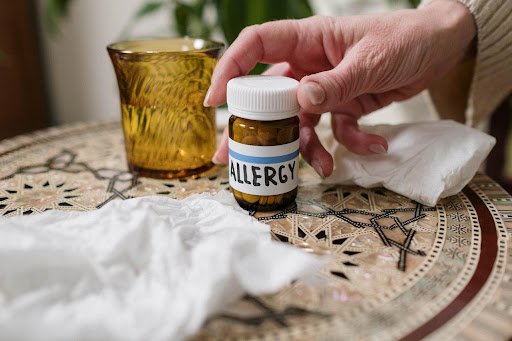When you think of allergic reactions, you probably imagine how itchy and unpleasant they are. However, some people go through serious allergic reactions that can be deadly. A life-threatening allergic reaction is called anaphylaxis.
Anaphylaxis is a serious allergic reaction that can affect the whole body in a short time. If the reaction is not treated immediately, it can be fatal.
An allergic reaction is known as a hypersensitive reaction of the immune system to a foreign substance or substance that the body perceives as foreign. These reactions are usually caused by exposure to environmental factors such as dust mites, mold, pet dander, or pollen. However, allergic reactions may also occur in response to medication, foods, bee stings, or latex.
Table Of Contents
Take precautions while cleaning
If you are cleaning your home, you must take precautions while cleaning to avoid allergic reactions. Even though cleaning your home can be dull and monotonous, it is crucial to do so. Not only will this benefit your health by removing harmful allergens and microorganisms from your home, but it will also help keep your home clean and organized manner. However, it is while cleaning that people often forget to take precautionary measures.
Allergic reactions to household cleaning supplies are a common problem and one that can be prevented by taking simple steps. By following a few simple steps around cleaning your home, you can not only prevent allergic reactions but also make your home more comfortable and less toxic.
Allergic reactions to cleaning products are quite common. You can easily get rid of all the cleaning products in your home and replace them with a few simple ingredients you probably already have in your kitchen. These ingredients are not only natural and safer for your health, but they will also leave your house smelling amazing.
Ensure there is no mold in the house
Mold can easily grow on wet surfaces such as the ground, in the basement and in the attic. The water can come from a leaky pipe, a broken roof, or a roof that allows rain to fall directly into the attic or basement. When a wet area is exposed to sunlight, it can grow mold.
Mold is a fungus that can grow in any area of the house, including the basement, kitchen, bathrooms, laundry room, and even inside walls and windows. Mold grows not only on the surface of materials but also within them, which is why taking care of the mold is important. Eliminating mold from your home is the first step in preventing allergic reactions.
Keep pets out
As anyone who has ever suffered from allergies can tell you, the symptoms can be anything from itchy skin to a runny nose. While you can’t always control what causes your allergies, you can control how you react to them.
Pets can be wonderful creatures. They can be sweet, cuddly and loving, but they can also be the root cause of your allergies. If you are allergic to cats or dogs, you will want to keep them out of your bedroom.
Keeping your pet out of the bedroom when you are trying to sleep can be difficult, but there are a few things you can do. First, you can shut your pet out of the room with a door that locks. If your pet is an indoor pet, you can also keep the bedroom door closed at night.
If you have a small dog, you can consider buying a doggy door that opens from the inside only. These can be purchased at a number of pet stores and will help your pet get outside to go to the bathroom at night.
Always check the ingredients for allergens
Allergic reactions are a growing problem in the US. In fact, 9 million people are affected by them. This means that those with allergies have to be extra careful. They may need to avoid certain foods or wear medical alert jewelry.
It’s important to know what you can and can’t eat. You probably won’t find ‘may contain peanuts’ on the label, but some food producers use peanut or nut products. It’s vital to check the ingredients list before you buy. It’s not just food you need to be careful of. You might also need to avoid certain beauty products, cleaning products, and even pets.
If you have a family history of food allergies or intolerance, it is best to be prepared for the worst. Always check the ingredients of the food you are about to eat. Ingredients are listed on the product label, so take the time to read them.
Even if you think you know what is inside the product, read it again. If you were not able to identify any ingredients you are allergic to, ask your server or a member of the staff. It is always best to be safe than sorry.
Read food labels
Reading food labels can be tricky, especially when some products contain several ingredients. The most common food allergens are milk, egg, peanuts, tree nuts, soy, wheat, fish and shellfish.
Allergic reactions to food can range from mild to life-threatening. They can range from mild to life-threatening if they are not addressed with the right treatment in time. However, the good news is that you can easily prevent allergic reactions to food by simply reading food labels.
The label should tell you if these ingredients are included in the food you are about to purchase. If you are unsure of an ingredient, search for it in the federal database of allergen information.
Use a separate cutting board and kitchen utensils
You can prevent allergic reactions by taking good care of your cooking utensils, says Brooke F. Rubin, MD, a board-certified allergist and immunologist in New York City. Use a clean cutting board and other tools for preparing your food.
Don’t use the same cutting board for preparing your food and for cutting up anything else. Also, don’t use the same kitchen utensils for preparing food that you use for serving food at the table.
When preparing meals, it is important to use a separate cutting board and kitchen utensils for safe food for you and your family to consume. Avoid cross-contamination by separating meat and meat products, fish and fish products, and dairy and dairy products.
When preparing food containing peanuts, tree nuts, fish, and shellfish, the same utensils, cutting boards, and countertops should not be used to prepare food that is safe for you and your family.
Understand what causes our allergies
Your body is a complex system, with all of its parts working in harmony. The goal of your immune system is to protect you from pathogens and other harmful substances in your body and the environment that could make you sick or even kill you.
When your body detects something that it perceives as a threat, your immune system releases chemical signals that help defend your body against the threat and sometimes trigger other parts of your immune system. One of these chemical signals is histamine, which is responsible for many allergic reaction symptoms.
Allergic reactions are quite common in the modern world, and many different things can trigger them and can be identified with simple allergy testing. What causes allergic reactions is often the result of the immune system reacting to something in the environment.
For example, someone might be allergic to a certain food, and their body treats it as a threat. This is why people often experience symptoms like redness and swelling when they eat a food they are allergic to.




